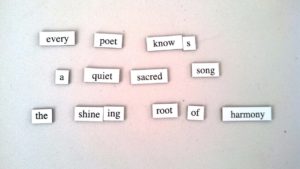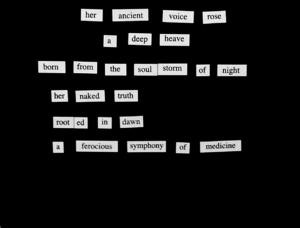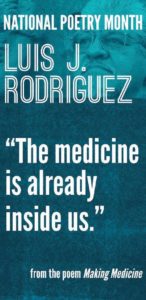By David Saucedo
The Reinforced Earth Company is a precast concrete company that is part of a national and international conglomerate comprised of construction, technology and concession companies, among others. We are located in China Springs and we employ between 150 to 160 people, many of which are Waco residents.
My personal passion for community change and empowerment has played out in many ways over the last four to five years, but the last two years have been amazing! When I was hired at Reinforced Earth in 2013, I never thought the most enlightening and fulfilling work so far would take place at this company, but it has. I was blessed with opportunities, and I advanced to become the Safety Coordinator in late 2013. This promotion opened doors that I would have never imagined and allowed me to work with some terrific people who have taught me a great deal about what we call “foundational employment” – employment that is foundational to a stable lifestyle.
The Reinforced Earth Company’s Waco plant, managed by James Ashley, is paving a new road in employee development. We focus on a quality made product, produced in a timely manner, as safely as possible. But most importantly we are aiming to promote healthy and stable lifestyles to the men in our community that work here. From a business perspective, it goes without saying that a high turnover rate interferes with those goals and makes it very hard to establish maximum efficiency. In 2014 our company on average employed 58 workers per month through local staffing agencies. This not only increased the cost of producing our product, but it also led to a workforce with less experience and more potential for mistakes or injuries.
We began our work in foundational employment by using encouraging messages in our safety toolbox meetings. For example, we would use words like, “This is a family out here,” or “We want you to use Reinforced Earth as a foundation for your family.” We encouraged car pools to help employees who didn’t have transportation, showing that we are here to help. We introduced simple budget spreadsheets and encouraged employees to ask how they could escape the check-to-check lifestyle. Our most recent, and I think our most fruitful step has been referring and encouraging our employees to a local psychiatrist that is covered by our insurance. In some cases we even covered the copay for employees who are more serious about improving their standard of living.
I’m very proud to report that this month we will be reporting that fewer than 20 employees are working at Reinforced Earth through local staffing agencies. We have increased production and decreased our production hours by improving our production procedures and focusing on better training and efficiencies. By no means would our efforts be considered a comprehensive study, but we are seeing results and we associate these results with the investments we are making in our employees.
From these experiences, I’m very confident that a company dedicated to promoting strong foundations in the lives of their employees will see improvements in the quality of their workforce, a decrease in their turn over, a reduction in overhead, and — the icing on the cake — an increase in their profits. What would our community look like if more companies were encouraged to promote strong and healthy foundations in the lives of their employees? That’s a question I have been asking myself more and more.
 This Act Locally Waco blog post was written by David Saucedo. David is a local minister with Life Church Waco and has committed the last 8 years of his life to impacting his community in a positive way. David has a loving wife, Michelle and three beautiful children, Lianna (7), Isaiah (4) and Isaac (10 Months).
This Act Locally Waco blog post was written by David Saucedo. David is a local minister with Life Church Waco and has committed the last 8 years of his life to impacting his community in a positive way. David has a loving wife, Michelle and three beautiful children, Lianna (7), Isaiah (4) and Isaac (10 Months).
The Act Locally Waco blog publishes posts with a connection to these aspirations for Waco. If you are interested in writing for the Act Locally Waco Blog, please email [email protected] for more information.
By Donna McKethan
In the Fall of 2015, the Greater Waco Advanced Health Care Academy (GWAHCA) will open its doors to Waco area juniors and seniors who are interested in pursuing a career in the health care industry. The Greater Waco Advanced Health Care Academy is a unique and innovative collaboration between the local health care community and Waco Area School Districts. GWAHCA will create a challenging learning environment that encourages high expectations for student success in the Health Care Field. The academy will empower students to successfully be competitive and workforce ready in our community and a global society.
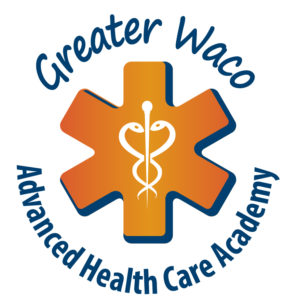 GWAHCA follows a model similar to the Greater Waco Advanced Manufacturing Academy, which aims to give students a head start in careers in welding and manufacturing. Officials from area school districts, McLennan Community College, Texas State Technical College and area health care industry leaders have been meeting over the last two years to determine health care industry needs and how to best serve students. The twin philosophies of realism and experimentalism are embedded in the attitudes and beliefs behind the planning and remodeling of GWAHCA. These philosophies have been expressed by the members of the GWAHCA Executive and Steering Committees. The idea behind not only the curriculum but also the facility is to give students an experience that aligns with what they will encounter when they graduate and begin a career in the health care industry. Partners support GWAHCA, an academy that fosters a sense of community among students, staff, parents, partners and neighbors. GWAHCA students will develop a sense of self-esteem and respect for themselves and others. Through a diverse and challenging curriculum, focusing on basic science, GWAHCA will cultivate student interest in various sciences and health professions. GWAHCA will provide a quality education and experiences that will prepare students to develop the academic, social and personal qualities necessary to realize their fullest potential as lifelong learners and productive, caring citizens of the world.
GWAHCA follows a model similar to the Greater Waco Advanced Manufacturing Academy, which aims to give students a head start in careers in welding and manufacturing. Officials from area school districts, McLennan Community College, Texas State Technical College and area health care industry leaders have been meeting over the last two years to determine health care industry needs and how to best serve students. The twin philosophies of realism and experimentalism are embedded in the attitudes and beliefs behind the planning and remodeling of GWAHCA. These philosophies have been expressed by the members of the GWAHCA Executive and Steering Committees. The idea behind not only the curriculum but also the facility is to give students an experience that aligns with what they will encounter when they graduate and begin a career in the health care industry. Partners support GWAHCA, an academy that fosters a sense of community among students, staff, parents, partners and neighbors. GWAHCA students will develop a sense of self-esteem and respect for themselves and others. Through a diverse and challenging curriculum, focusing on basic science, GWAHCA will cultivate student interest in various sciences and health professions. GWAHCA will provide a quality education and experiences that will prepare students to develop the academic, social and personal qualities necessary to realize their fullest potential as lifelong learners and productive, caring citizens of the world.
The first programs to be offered at GWAHCA will be the Certified Nursing Assistant (CNA) and Advanced CNA programs. The CNA curriculum will follow the current program offered at McLennan Community college. The Advanced CNA course is being developed in collaboration with Providence and Baylor Scott and White (Hillcrest) Hospital Staff. This curriculum development is an exciting process and will result in an amazing and rigorous program. In addition to the CNA course, juniors will also take Anatomy & Physiology, Counseling and Mental Health and Medical Terminology. Seniors (who have completed the CNA certification) will take Phlebotomy and a soft skills course that will include training in the hospitals computer system. Both hospitals have promised to hire all students who successfully complete the Advanced CNA program.
GWAHCA will be located on the campus of the former Viking Hills Elementary school. The campus is located on Viking Drive just off Fish Pond Road. All Juniors and Seniors within 45 minutes of the academy are eligible to attend. Applications are currently being accepted. For more information, contact Donna McKethan (254 755 9573 or [email protected])
 This Act Locally Waco blog post was written by Donna McKethan. Donna is the Career and Technology Director at Waco ISD. She has 33 years in education, the last 15 with WISD Career and Technology. She is currently the President of The Career and Technology Association of Texas. She is a WISD graduate with a BS in Home Economics Education from Baylor University and an MS of Education from Tarleton State University. She is currently enrolled in the Doctorial Program in Educational Leadership at Tarleton State University.
This Act Locally Waco blog post was written by Donna McKethan. Donna is the Career and Technology Director at Waco ISD. She has 33 years in education, the last 15 with WISD Career and Technology. She is currently the President of The Career and Technology Association of Texas. She is a WISD graduate with a BS in Home Economics Education from Baylor University and an MS of Education from Tarleton State University. She is currently enrolled in the Doctorial Program in Educational Leadership at Tarleton State University.
The Act Locally Waco blog publishes posts with a connection to these aspirations for Waco. If you are interested in writing for the Act Locally Waco Blog, please email [email protected] for more information.
By James Karney
Let’s go!
Batter up!
We’re tak-ing the af-ter-noon off!
It’s a beau-ti-ful day for a ball game, for a ball game to-day
The fans are out to get a ticket or two
From Wal-la, Wash-ing-ton to Kal-a-ma-zoo
– It’s A Beautiful Day For A Ball Game by Harry Simone
Spring is here and baseball opening day pitches are being thrown out from the Big Leagues to Little League.
In the Waco area hundreds of youth participate in Little League Baseball and Softball learning playing skills, teamwork, sportsmanship and character. I’d like to share with you about a division of Little League you probably did not know existed.
Challenger Little League provides the opportunity for children with physical, intellectual and developmental disabilities to play Little League baseball. During the April and May season, 125 area children play on a specially outfitted field with solid surface base paths at the Lake Air Fields with dedicated coaches and buddies guiding them. No matter the ability or skill level, “everyone plays!”
 This year Challenger Little League in Waco celebrates its 25th season with children and teens from age 5 to 18 playing on ten teams. Challenger baseball came to Waco in 1990 as one of the first locations in Texas with 34 children participating that year.
This year Challenger Little League in Waco celebrates its 25th season with children and teens from age 5 to 18 playing on ten teams. Challenger baseball came to Waco in 1990 as one of the first locations in Texas with 34 children participating that year.
The kids have a great time just being kids playing ball and for parents it’s a little bit of normalcy just sitting in the bleachers with other parents watching their children play Little League baseball like any other parent.
 My son Jamie has played in Challenger since 2004 and I’ve been a coach since 2009. It’s been a great experience for both of us. When Jamie first played he’d hit the ball, run down to first base and then keep running straight down the right field line all the way to the outfield fence. Over the years his skill level has increased and he now hits a pretty mean line drive. I look forward to April and May, getting out my glove from high school and playing with the kids.
My son Jamie has played in Challenger since 2004 and I’ve been a coach since 2009. It’s been a great experience for both of us. When Jamie first played he’d hit the ball, run down to first base and then keep running straight down the right field line all the way to the outfield fence. Over the years his skill level has increased and he now hits a pretty mean line drive. I look forward to April and May, getting out my glove from high school and playing with the kids.
Challenger would not be possible without dedicated volunteers who manage league operations, coach, serve as buddies or team and league sponsors. Lupe Rosas, Don Deatherage and Michelle McCollum have worked with Waco’s Challenger League from its beginnings in 1990. Others like Coleen Ostrom and Pepper Jones make things run smoothly every year arranging for uniforms, volunteer buddies, fundraisers and more. Each of the ten Challenger teams has two or three coaches. Many of the coaches, like in other Little League divisions, are parents who want to share their love of baseball and sports with their son or daughter.
 At every game you will also find buddies for the players. Buddies play a vital role in the game by being paired up with a player to provide them assistance they might need from pushing a wheel chair, putting on a batting helmet, keeping them focused on the game (and not watching airplanes flying overhead.) and most importantly encouragement.
At every game you will also find buddies for the players. Buddies play a vital role in the game by being paired up with a player to provide them assistance they might need from pushing a wheel chair, putting on a batting helmet, keeping them focused on the game (and not watching airplanes flying overhead.) and most importantly encouragement.
Some buddies volunteer for the season while others come out for a game or two. These buddies are frequently from other Little League teams or high school baseball and softball teams. Last season members of the Baylor Lady Bear’s Softball team were buddies at one of our games. The buddies also allow parents a period of respite to sit in the stands, visit with other parents and cheer on their little sluggers.
Team sponsors are another part that makes Challenger Little League possible by providing funding to help underwrite costs. For the 2015 season team sponsors are:
 The Don Deatherage Challenger Field is located near the City of Waco’s Cobbs Recycling Center by Lake Air Fields 4 & 5. Games are played Tuesday and Thursday evenings at 6pm and 7pm and on Saturday morning’s beginning at 9am. Opening day games are this Saturday, April 18. (Facebook: Challenger Little League in Waco.)
The Don Deatherage Challenger Field is located near the City of Waco’s Cobbs Recycling Center by Lake Air Fields 4 & 5. Games are played Tuesday and Thursday evenings at 6pm and 7pm and on Saturday morning’s beginning at 9am. Opening day games are this Saturday, April 18. (Facebook: Challenger Little League in Waco.)
Come on out some evening or Saturday morning and cheer on these great athletes!
 This Act Locally Waco blog post is by James Karney. James worked in a library beginning in his sophomore year of high school and after a more than thirty year library career recently retired as Director of the Waco-McLennan County Library. He’s currently taking a sabbatical working on projects around the house, catching up on reading and doing research on Texas statesman Coke Stevenson. He has been married to the super amazing and talented Anita Karney for 20 years and their son Jamie is a junior at Midway High School.
This Act Locally Waco blog post is by James Karney. James worked in a library beginning in his sophomore year of high school and after a more than thirty year library career recently retired as Director of the Waco-McLennan County Library. He’s currently taking a sabbatical working on projects around the house, catching up on reading and doing research on Texas statesman Coke Stevenson. He has been married to the super amazing and talented Anita Karney for 20 years and their son Jamie is a junior at Midway High School.
If you would like to write a post for the Act Locally Waco blog, please contact Ashley Thornton by email at [email protected] .
By Alfred Solano
What do new bike lanes, the Hippodrome reopening, Franklin Place, Dichotomy, Lula Jane’s, Muddle, Tinsley Place, Barnett’s Pub, and McLane Stadium all have in common? They’re all recent developments that have collectively changed the landscape of Downtown Waco during the past few years.
In 2010, we, as a community, began to dream and imagine what we want our city to look and feel like. The Imagine Waco plan was developed and adopted. Five years later, we look around and see a new, livelier downtown—one which we proudly call home. However, there is still much to accomplish. As we plan for the next five years of growth and development, we need to update the Imagine Waco plan and include everyone’s voice.
When the Imagine Waco plan was adopted in 2010, goals included activating the riverfront, building connections for people to get around, and creating an organization that implements development in Downtown Waco. More than two-thirds of Imagine Waco’s proposed action items are in the realization process. Over the past five years, public space investments have included improvements to sidewalks and crosswalks, added bike lanes, and new trees that have been added along streets to upgrade the walkways. Future shared spaces will include the transformation of the Heritage Square parking lot and the riverfront. Some of the private sector developments (leveraged by public investments) include Franklin Place, Tinsley Place, the Hippodrome, and Lula Jane’s. A small area planned for the “Near Northside” area around 15th and Colcord resulted in increased public and private investments, including streetscape improvements that beautified the intersection.
Organizational developments included the creation of the Downtown Development Corporation, 1,000 Friends of Waco, and efforts by the Sanger Heights and North East Riverside Neighborhood associations to improve their areas and business districts, according to the Imagine Waco plan.
Behind the scenes, the City of Waco has embedded principles from Imagine Waco into planning and engineering decisions. This paradigm shift has changed the design and the feel of projects and Downtown Waco altogether.
As we look at the first years of Downtown Waco’s renaissance and the series of projects that have been accomplished by private investors and the City during the last five years, we look ahead with excitement and anticipation about what is next for our city.
Five years ago, the Waco community dreamed together…and now it’s time to dream again!
What makes The Imagine Waco plan achievable and exciting is that it is designed by the people who live and work in the Waco area for the benefit of the entire Waco community. We want your dreams and aspirations to be a part of the Imagine Waco update. Next week, there will be severral opportunities for your voice to be heard. Everyone is invited and encouraged to give their input about the future of Downtown Waco.
- Monday, April 13th, The Jubilee Theater @ 6PM
(1315 North 15th Street, Waco, TX 76707) - Tuesday, April 14th, The Cen-Tex Hispanic Chamber of Commerce @ 6PM
(915 LaSalle Avenue, Waco, TX 76701) - Wednesday, April 15th, The Greater Waco Chamber of Commerce—1,000 Friends of Waco Meeting @ 10AM
(101 South 3rd Street, Waco, TX 76701) - Thursday, April 16th @ The Eastern Waco Development Corporation, 6PM
(715 Elm Street, Waco, TX 76704)
Is there something that was missed or left out of the initial plan? Are there some good things in Waco that could be made great? What do you want Downtown Waco to be known for? Come share your thoughts and let us know.
Waco’s beautifully diverse culture deserves your continued support. Let’s continue to work together to build up Waco in a way that benefits everyone!
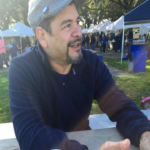 Alfred Solano was raised in Waco and is the Sales Manager for Texas Document Solutions. He and his wife Rachel are passionate about our city’s current trends and future possibilities. Alfred is the Vice President of the Business Resource Center, Waco’s downtown development corporation. He has served on the Board of Directors since its formation in 2011, representing the Cen-Tex Hispanic Chamber of Commerce.
Alfred Solano was raised in Waco and is the Sales Manager for Texas Document Solutions. He and his wife Rachel are passionate about our city’s current trends and future possibilities. Alfred is the Vice President of the Business Resource Center, Waco’s downtown development corporation. He has served on the Board of Directors since its formation in 2011, representing the Cen-Tex Hispanic Chamber of Commerce.
The Act Locally Waco blog publishes posts with a connection to these aspirations for Waco. If you are interested in writing for the Act Locally Waco Blog, please email [email protected] for more information.
By Jenuine Poetess
April is many things to many people. For some, April is about Autism Awareness & Advocacy. For others April shines a light on the presence of Child Abuse and how to prevent violence against youth in their homes. Some people celebrate their pets in April, other people honor the Earth, still others may go fly a kite. Here at the Arts & Culture blog, we’re celebrating Poetry! Among the myriad of causes, April is National Poetry Month. Established in 1996 by the American Academy of Poets, National Poetry Month strives to not only draw attention to poets and their works but also to inspire others to try their hand at writing verse. Poet Maureen Thorson is credited with initiating the NaPoWriMo challenge in 2003 in which participants endeavor to write 30 poems in 30 days throughout the month of April. If you are feeling ambitious, it’s not too late in the month to begin; check out the NaPoWriMo website for daily prompts and tips!
As a poet, sometimes I forget that for many people, poetry serves little to no purpose in their daily lives. Actually, this is quite a shocking realization for me to remember. I’ve been writing poems, in some form, since I was a little girl. I was a non-committal open mic attendee for many years after college and wrote every now and then when I was so moved. It wasn’t until I began attending weekly open mics and womyn’s writing circle at Tia Chucha’s Centro Cultural in Sylmar, CA in 2009 that I finally claimed my identity as Poet and began seriously practicing the written and spoken-word arts. I quickly found poetry to be my new way of life. I relished the rebellion of breaking grammar rules to arrange words on the page, without a care for punctuation or use of articles. Words themselves became the adornments of my expressions. Pure. Undiluted. Raw. Within this realm of reckless, wild, word-play, I found my own voice. I have known no other liberation so exhilarating as beholding the reflection of myself in the words I have poured upon my pages. I am certainly not the first, no the last to embark on this journey of self-knowing via pen and paper. Science fiction author, Octavia Estelle Butler affirms, “Every story I write, creates me. I write to create myself.”
Poet W. B. Yeats asserts, “out of the quarrel with others we make rhetoric out of the quarrel with ourselves we make poetry.” It is from within that quarrel with one’s self, that the truest aspects of our soul remain refined, after everything else has burned away. For most poets I know and by whom I am inspired, we write to shed light on truth with very little interest in keeping ourselves or others comfortable. The visceral art of poetry is to be unsilent, to provoke, to protest, to be—unflinching and unapologetic. It is up to the reader to divine meaning, to interpret call to action, to take away value.
Without hesitation or embellishment I candidly admit that poetry has saved my life on countless occasions. Whether it is the catharsis of purging my turmoil, heartache, outrage, or euphoria onto the page; or the validation of listening or reading others’ words putting into language thoughts, feelings, moments I too have experienced; or the deep joy of witnessing another come into bloom, finding their own voice and raising the volume to speak, with authority, their truths; writing has saved and changed my life. Mine is not the only testament to this fact. From youth and adults in correctional facilities, to those doing the work in therapy sessions, to cancer patients working through their mortality, to the grieving remembering their loved ones lost, to hearts pounding in love and desire, to joyful wonder captured spontaneous, people world-wide speak fluently the language of poetry.
Historically, poetry has been a dangerous occupation getting writers excommunicated at best and executed at worst. We have been outcast and exiled, tortured and isolated, we have been misunderstood and hated since the dawn of poetry. I promise you, it is not for the faint-of-heart. Poetry is born out of marrow and mire. It is a Phoenix rising again and again out of the ashes of our souls, the glowing remnants of what has been destroyed. Poetry is our rebirth. We write to know ourselves and we share to know each other. This is how we build community, through our creative expressions. Through speaking our truths. Through listening, with intention, to what each other is saying—deep within our words.
I do not write because it is nice or fun. Poetry is not a hobby or leisure activity. Poetry is among my personal hierarchy of needs. I must write. When my words are quiet, I feel it; I know it is a grave vital sign of my distress. Poetry is my compass and my map. Poetry is my truest mirror showing me unedited reflections of myself. Poetry is my measure and my portion. Poetry is both a part of me, and something entirely beyond me, all at once.
Get Involved!
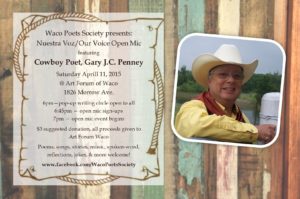 Waco Poets Society hosts an open mic every 2nd & 4th Saturday at the Art Forum of Waco, 7pm and welcomes the sharing of poems, songs, stories, spoken-word, reflections, jokes, and more!
Waco Poets Society hosts an open mic every 2nd & 4th Saturday at the Art Forum of Waco, 7pm and welcomes the sharing of poems, songs, stories, spoken-word, reflections, jokes, and more!- Challenge yourself to write 30 poems in 30 days—yes! haiku count! J
- Attend readings at the Austin International Poetry Festival featuring Nikki Giovanni April 9th-12th
- Attend Waco’s Annual WordFest, a part of the Waco Cultural Arts Festival in September 2015
- Stop by the Waco Poets Society booth any 2nd Saturday at the Waco Downtown Farmers’ Market to try your hand on our vintage typewriter or to play with magnetic words
Resources:
These are some of my go-to resources for practicing, contemplating, and exploring the written & spoken-word arts.
- NaPoWriMo – prompts and tips for writing 30 poems in 30 days of April
- Poem Crazy: freeing your life with words – by Susan G. Wooldridge
- Poetry as Spiritual Practice: using Poetry in Your Daily Rituals, Aspirations, and Intentions – by Robert McDowell
- Writing the Life Poetic: An Invitation to Read and Write Poetry – by Sage Cohen
- Skipping Stones is a rich multicultural literary and arts magazine for children and youth
 Jenuine Poetess is an artist, visionary, and community organizer. In 2010, she founded In the Words of Womyn (ITWOW), an international, grass-roots, written and spoken-word arts project with chapters throughout Los Angeles; Waco, TX; and Lebanon. ITWOW empowers womyn of all ages to give sound to our story and volume to our voice.HOT~ITWOW writing circle meets Mondays from 6-7:45pm at the Art Forum of Waco beginning February 2, 2015. Jenuine also founded Waco Poets Society which sponsors a local open mic venue in Sanger Heights. Meeting every 2nd & 4th Saturday at the Art Forum of Waco Nuestra Voz Open Mic invites community to share poems, songs, stories, spoken-word, and other creative expressions! In 2015, Jenuine along with a number of other artists creating and residing in Waco, co-founded the Central Texas Artist Collective (click link to learn more and get involved). You can contact her at: [email protected].
Jenuine Poetess is an artist, visionary, and community organizer. In 2010, she founded In the Words of Womyn (ITWOW), an international, grass-roots, written and spoken-word arts project with chapters throughout Los Angeles; Waco, TX; and Lebanon. ITWOW empowers womyn of all ages to give sound to our story and volume to our voice.HOT~ITWOW writing circle meets Mondays from 6-7:45pm at the Art Forum of Waco beginning February 2, 2015. Jenuine also founded Waco Poets Society which sponsors a local open mic venue in Sanger Heights. Meeting every 2nd & 4th Saturday at the Art Forum of Waco Nuestra Voz Open Mic invites community to share poems, songs, stories, spoken-word, and other creative expressions! In 2015, Jenuine along with a number of other artists creating and residing in Waco, co-founded the Central Texas Artist Collective (click link to learn more and get involved). You can contact her at: [email protected].
By Janae Griffiths
We are all busy people. We go about our days checking tasks off our lists, sometimes putting little thought into what we are actually doing. Often, this is harmless—we get everything done and no one gets hurt in the process. But, for those of us who have the opportunity to walk alongside someone in difficult circumstances or to offer assistance in a unique way, rushing through can do more harm than good.
I had not given this much thought until a few weeks ago, when I met with a wonderful woman named Stella. Stella lives here in Waco, and due to some life circumstances has found herself to be the recipient of multiple social services in our community. She shared with me part of her story—a part that made me uncomfortable. Stella spoke of feeling forced to become her own advocate, of not knowing what resources were available to her or how to tap into them. She felt like she couldn’t find anyone who would take the time to explain the available resources to her.
She told me about how she has sometimes felt like she was just another item to be checked off of someone’s to-do list. She felt like she was falling through the cracks, but had no way to stop it.
“The professionals need to be proactive in spreading information,” she explained. “They need to have the passion to go above and beyond, not just rush through.”
I didn’t know how to respond to her at first. I wasn’t with Stella as she made her way from place to place seeking help. I don’t know how the people working with her actually responded, the words they actually said, the looks on their faces, or the tone of their voices. I don’t know the pressures they were under, or how long their days had been, or even how Stella treated them. I certainly don’t know their intentions. I don’t know if they felt empathy, or annoyance, or kindness, or frustration. I don’t know if they tried their absolute best to help, or if they did indeed feel like Stella was just “another item to be checked off.”
I only know how Stella felt.
“In some places I felt valued, but in many places, I did not,” Stella explained. From her point of view, the people who worked with her seemed to expect that she would automatically know what was available to her, when she felt like no one had ever clarified what services she qualified for and which she did not. She felt uncomfortable and short on information.
As a graduate student at Baylor School of Social Work, I have spent the past two years interning for various Waco nonprofits and working to address needs in our community. One of the key values of the social work profession—which we are taught right at the start of Baylor’s program—is the inherent dignity and worth of every individual. I absolutely believe that every human has dignity and worth, and I am fairly certain that the Waco nonprofit and social service community as a whole believes the same. But, while I may believe those things in my mind, Stella’s story made me start to think about how much more challenging it is to honor those values in my day to day actions.
Of course social service professionals shouldn’t just rush through their work. We all know that. But, in the day in and day out busyness of the work day, it is easy to do.
Fortunately, Stella is a strong woman with a strong personality. She quickly educated herself on the resources available and became an advocate for herself and others that she knew. But, as she pointed out to me, not everyone can easily become their own self-advocate, especially individuals whose primary language isn’t English.
I deeply appreciate Stella sharing her experience with me. I have been reflecting on her words in the weeks since, and they have reminded me about why I entered the field of social work in the first place. I want to be someone who meets people where they are, recognizes them for who they are, and cheers for them as they take steps to become more. My hope is that I, as a member of the social service community in Waco, can approach my work with a renewed sense of the dignity and worth of each individual I have the opportunity to serve. My hope is that I never rush through my work, but take the time to treat each client with kindness and offer as much assistance as I am able.
I hope that I always remember Stella and how she feels. I hope I always remember how uncomfortable it feels not to have the information you need, how bad it feels to be treated like “another item on the list,” how scary it feels to be “falling through the cracks.” I hope that my actions with each person who comes my way will reflect the values I so fervently believe.
 This Act Locally Waco blog post was written by Janae Griffiths. Janae is originally from Chicago, but has been happy to call Waco her home for almost six years! She is finishing her Master of Social Work degree from Baylor University, and currently interns at the Texas Hunger Initiative. She is passionate about issues of poverty and justice, especially in our community.
This Act Locally Waco blog post was written by Janae Griffiths. Janae is originally from Chicago, but has been happy to call Waco her home for almost six years! She is finishing her Master of Social Work degree from Baylor University, and currently interns at the Texas Hunger Initiative. She is passionate about issues of poverty and justice, especially in our community.
The Act Locally Waco blog publishes posts with a connection to these aspirations for Waco. If you are interested in writing for the Act Locally Waco Blog, please email [email protected] for more information.
By Carrie Kuehl
A ribboned birthday gift and the contents of your front seat fly onto the floor as you slam on the brakes to avoid hitting the car in front of you that just slammed on its own brakes. A squatty, blond dog with long ears squeals with the heavy bump of the car’s tire. He dashes to the safety of a front yard, still crying and licking at his paw. He has a bruised shoulder and skinned back foot. You are late for the party, but it’s no big deal.
Sleep has become a rare luxury since the pregnancy. Your toddler is teething and inconsolable. As the two of you finally doze off, two toms and a female begin vocalizing with mating wails which are heard outside the kitchen window, throughout the subdivision, and in the ears of your baby. Sigh…another chance to sleep will come tomorrow night; it’s no big deal.
The ambitious, dream-filled couple from Ohio are trying to decide: will they relocate to Waco or to Greenville, S.C.? They have good job possibilities in both. After a smooth flight they drive along Lake Shore Drive in their rental car. A new future is dancing through their minds when they see a dark shape in the road. It’s the contorted body of a beagle mix, similar to his boyhood best friend who was put to sleep in his arms only a few years before. Three blocks later they meet their realtor at charming little house in a neighborhood with big trees and just the kind of character they were hoping to find. The little house is so cute they almost don’t notice the thick, fluffy dog nosing through garbage and strewing it all over the yard next door and into the street. They do wrinkle their noses a little when the animal waste stench from a porch and yard across the street wafts into their nostrils. The real estate agent dismisses this as common. The couple decides to pursue the opportunity in Greenville. “Drat! I really thought we had them!” the realtor thinks as she hangs up the phone after hearing the news. “Oh well, you can’t win’em all. It’s no big deal.”
If you are still reading, you are likely an animal lover, or even if you aren’t, you have a deep concern and a strong sense of ownership for the future of Wacotown.
In 1988 a group of similarly concerned and dedicated Wacoans got frustrated with the neglect and suffering of animals and the negative effect this neglect was having on our city. When they found they could not get ahead of the problem by spending their free time cleaning poop at the animal shelter, this visionary group took the initiative to begin a spay/neuter program. The goal of this program was to prevent the suffering and dying of unwanted animals by preventing the births of unwanted litters.
That was a quiet year for spay/neuter. The clinic was only open one day a week back then, and they performed about 15 surgeries for cats or dogs a day. Today at the Animal Birth Control Clinic it is common for our licensed veterinarians and supportive staff of veterinary technicians to perform over 50 high-quality, affordable spay and neuter surgeries a day, five days a week. Back then huge numbers of cats and dogs poured into our rescue centers and into the shelter by the dozens daily, now the daily intake rarely goes over 25. And to top it off, our community just celebrated its third month of No Kill (90% or more of the animals exit alive)!
This decreased intake has been made possible because of a perfect mix of donor and taxpayer-funded spays and neuters, and because of transparent communication among goal-focused partners. We all benefit from the safer living and higher quality of life that is the result of this reduced burden on our community.
The next step is upon us. The shelter is being reconstructed to properly care for the remaining cats and dogs who find themselves in need of temporary care. The community campaign, heartily led by Mayor Malcolm Duncan, is wrapping up within weeks. I welcome you to contribute to this project and to support spay/neuter.
The reasons to support spay/neuter and to continue to lift this burden on our community are tangible and intangible, direct and indirect. Here are a few:
- To enjoy your afternoon birthday party rather than having it derailed by a car accident because the car in front of you hit a stray,
- To have a peaceful night of sleep and sanity for yourself and your toddler because the feral cat mating “opera” has been taken off of the marquee,
- To woo young professionals to our Waco neighborhoods instead of giving them a reason to start their bright futures elsewhere.
Quality of life and safety for humans intersects with the lives of the cats and dogs in our city more often than we sometimes realize. This work must continue. It IS a big deal, and it affects us all!
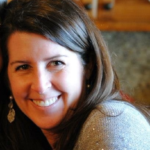 This Act Locally Waco blog post was written by Carrie Kuehl. Carrie is an enthusiastic Wacoan who began her time at the Animal Birth Control Clinic as a volunteer in 1994. Her BA in Sociology from Baylor, ten years in the financial planning/securities industry, and her passion for the efficiency of spay/neuter prepared her to become the Executive Director of ABC in 2006. In the last few years, Carrie has enjoyed growing the clinic and mentoring additional Texas communities to boost their spay/neuter impact. In her personal time, she enjoys kayaking, houseboating, and being an aunt.
This Act Locally Waco blog post was written by Carrie Kuehl. Carrie is an enthusiastic Wacoan who began her time at the Animal Birth Control Clinic as a volunteer in 1994. Her BA in Sociology from Baylor, ten years in the financial planning/securities industry, and her passion for the efficiency of spay/neuter prepared her to become the Executive Director of ABC in 2006. In the last few years, Carrie has enjoyed growing the clinic and mentoring additional Texas communities to boost their spay/neuter impact. In her personal time, she enjoys kayaking, houseboating, and being an aunt.
The Act Locally Waco blog publishes posts with a connection to these aspirations for Waco. If you are interested in writing for the Act Locally Waco Blog, please email [email protected] for more information.
by Christian Bolaños
“Baylor Bubble” [ bā-lər ˈbə-bull ] – Noun: A thin sphere enclosing Baylor University and living areas immediately surrounding its campus, from the rest of Waco.
Baylor was my dream school in the sense that it was out of my reach. But, like many who attend, I have parents that work day in and day out to give their children an opportunity to live a life they could only dream of. That, along with financial aid and academic scholarships, has kept me enrolled all four years.
The hefty Baylor price tag pays for a phenomenal faculty and a seemingly limitless number of opportunities waiting to be tapped by students eager to make a difference in the world. Baylor does an outstanding job at educating its students in their respective professions, and does so in such a way that students keep integrity and ethics ever-present and in the forefront of students’ minds. Baylor University’s course offerings include business ethics courses and an entire Medical Humanities degree program. Baylor’s Law School even includes “a study abroad program devoted to the art of advocacy” to ensure that Baylor attorneys represent the interests of their clients in the best manner possible.
There is, however, one inconsistency in all of this. As students we learn all kinds of skills out of textbooks filled with different scenarios, simulations and situations that are supposed to reproduce real life. I believe it’s a great way of teaching; it’s only missing one thing. Real life.
One of my professors offered a solution to this dilemma. We learned to call it “service-based learning,” and it made the biggest impact on me during my entire time in Waco. Despite all of the brilliant professors, state of the art facilities, and wonderful resources available on campus, one of the best, and most underappreciated opportunities that Baylor has to offer us as a valuable teaching lesson lies a few steps right outside of the “Baylor Bubble.”
I strongly believe that community service is the missing link for students. It gives us the chance to apply what we’ve learned in the classroom to real human needs. By breaking down the barrier between Baylor and Waco, we were able to more fully engross ourselves as citizens of Waco and better understand the dynamics of the city. The best thing that students can do during their time at Baylor is to participate as active members of the Waco community. For example, in one class I took, we not only learned the importance of grant writing, but we were actually able to apply for real world grants and actually help non-profit organizations in the area. Nearly every course could be tailored to include some form of service-based learning. I would urge those of you that are in school to come up with ideas with your teacher/professor on how you can take the learning outside of the classroom and do some form of work, no matter how big or small, that leaves an impact beyond that of a letter grade. And for those of you who are not in a classroom, find a place where you can serve. Even if you can only commit to an hour a week, there are plenty of places where you can make a world of difference.
I have gotten involved in the Waco community through an internship at the Public Health District. Through this involvement I have learned first-hand about the health challenges that many cities face such as a shortage of family practice doctors and lack of access to care among lower income neighborhoods. I have also learned about the things a city can do to promote the health of its citizens, like creating programs and coalitions that serve to raise awareness and educate the general population on health disparities. Because of this understanding I will be a better, more informed citizen, whatever profession I end up pursuing and where ever I end up living. I consider this an extremely valuable part of my education, something that I wouldn’t have been able to experience had I not made the effort to work outside the Baylor Bubble.
Here is how Baylor’s strategic vision, Pro Futuris (“for the future”), describes Baylor’s role as an institution of higher education: “We strive to prepare students to make a difference in our world as citizens and leaders who have the faith and integrity to do what is right in the face of competing pressures and to have a passion to apply their knowledge to ends that transcend mere self-interest.”
Rather than only venturing out to Waco to grab a bite to eat or enjoy the nightlife, we should actively seek out opportunities for not only our growth, but also for the growth of Waco. It should be our duty as citizens to do our part and work towards building a better future. So start early and start now. It is never too late to begin making a difference in your community. And rather than being like the dreadful, monthly visit to the in-laws, community service should be something you (and hopefully your family or close group of friends, the more the merrier!) look forward to doing when you meet up. There are so many different ways to give time, each with its own positive impact on our community. Find something that you like. For a list of ways to serve Waco, click the following link http://www.waco-texas.com/volunteer.asp. Thank you.
 This Act Locally Waco blog post was written by Christian Bolaños. Christian is an intern at the Waco Public Health Department and a senior at Baylor University. His interests range from biology research and technical writing, to learning more about his rich Latino culture. Focused on helping the community as a whole, Christian ultimately plans to matriculate to medical school to become a surgeon. In the meantime, he plans on graduating in May and either pursue research interests or obtain a writing position in the medical field.
This Act Locally Waco blog post was written by Christian Bolaños. Christian is an intern at the Waco Public Health Department and a senior at Baylor University. His interests range from biology research and technical writing, to learning more about his rich Latino culture. Focused on helping the community as a whole, Christian ultimately plans to matriculate to medical school to become a surgeon. In the meantime, he plans on graduating in May and either pursue research interests or obtain a writing position in the medical field.
The Act Locally Waco blog publishes posts with a connection to these aspirations for Waco. If you are interested in writing for the Act Locally Waco Blog, please email [email protected] for more information.
By Serina Cole
Not everything that counts can be counted, and not everything that can be counted counts.” – Albert Einstein
For most of his young life Matt was excluded from many extra-curricular activities. He’s watched his friends and school mates have the opportunity to play ball, have fun, and live the life of a typical teenager while he sat and watched from the bleachers. Matt has autism and is known to have some very challenging behaviors. He was even turned away by his own school after wanting to join their Special Olympics team. Despite his intellectual disability, Matt has the same range of desires, needs, emotions and dreams as the rest of the population. “I just want to be on the team” — this was Matt’s dream. As a coach and Delegation Coordinator for Special Olympics, I work with a tremendous group of volunteers, and I knew we could help him achieve his dream. We invited him to become a Mosaic Mustang. At our first basketball practice he was so excited it was a disaster. After much patience, practice and encouragement from his team mates, coaches and staff — Matthew excelled at the individual basketball events. Little did I know that Matt enjoyed his time so much he began watching the Winter Olympics at home to learn how to become a true Olympic Champion.
Finally! It was time to compete. Matt carried the torch for our team in front of his friends and family. At every event he gave his all, doing the very best he could. During the medal ceremony, his faced beamed when they placed a gold medal around his neck. Without hesitation, he lifted the medal to his mouth and bit it as hard as he could. Confused by his actions, I later asked him why he did this — “Because, Mrs. Serina, that’s what real Olympic champions do.” In that moment, I realized we had a made a young man’s dream come true.
Throughout March we have been celebrating the possibilities of individuals with intellectual developmental disabilities. In doing so we must also celebrate many unsung heroes that help discover and tap into those possibilities — our volunteers. If it were not for my volunteers with Mosaic, Matt would not know the pride of being a champion.
Volunteers have an enormous impact on the health and well-being of our community. Think of all the ways they make a difference in day to day life. The ability of people to work willingly together for the betterment of their community and themselves is a valuable resource. Some might argue that with all of the economic stress and uncertainty in our country today, how can we realistically expect anyone to be willing to volunteer? This probably stems from the rather outdated perception that only bored, wealthy housewives and retirees engage in volunteerism. But actually, volunteers can and should come from all walks of life from all economic backgrounds, experience and interest. With many families struggling due to lack of time, financial resources or both, can we, as Wacoans really afford to give away our time and talents without compensation? Can we afford not to?
Let’s take a look at some numbers. Nearly 25% of Texas residents volunteer in some form or fashion. This equates to more than 4.8 million volunteers and 586 million hours of service according to data reported by the Corporation for National and Community Service. This is $13.2 billion in services contributed across Texas. Think about the financial impact if we were to replace these service hours with paid staff! These numbers are astounding, but what do they mean to us? Volunteers deliver critical services—from serving as volunteer fire fighters or participating in search and rescue, to delivering meals to homebound seniors or homeless youth. Volunteers tutor, teach, mentor, coach, and support young people with everything from math homework to dealing with personal crises. In my experience with Mosaic, it means an afternoon of arts and crafts, cooking classes, teaching sign language or just simply sharing an hour of your week to be a friend to someone who needs a compassionate ear or kind word.
Volunteering to work with individuals living with I/DD makes a difference to some of the most vulnerable members of your community. There is an overwhelming need for volunteers for this population of individuals, and in Waco there are many opportunities to serve. I encourage you, even implore you, to consider becoming a volunteer for a special needs individual, group or organization. Without our Mosaic volunteers, there would be a void we could not afford to fill.
Finally, here is one way to visualize the impact of volunteers in our community. Imagine if one day, all the volunteers simply did not show up? What would our community, parks, schools, places of worship and most non-profits in Waco look like? What opportunities to grow, learn, and thrive as a community would be lost?
Note: If you are interested in volunteer opportunities working with the I/DD population, please contact Serina Cole, Mosaic of Waco. 254-757-3434 Ext: 209 or [email protected].
 This Act Locally Waco blog post was written by Serina Cole. Serina lives in Cameron, Texas, but commutes over 120 miles a day to fulfill her passion to serve individuals with intellectual developmental disabilities. She has worked as the Community Relations Manager for Mosaic in Waco, to create opportunities for individuals with I/DD to pursue a meaningful life in a caring community, giving a voice to their needs. Serina is very involved in the I/DD community as a volunteer, educator and advocate. She volunteers as the Delegation Coordinator and coach for Mosaic’s Special Olympics team and serves as the Secretary for the Waco Mayor’s Committee for People with Disabilities. She is a recent graduate of Waco’s Leadership Plenty Institute, Class of 2014-2015. She states she has fallen in love with the Waco Community and how the city embraces the opportunity to serve, love, protect and care for those in need.
This Act Locally Waco blog post was written by Serina Cole. Serina lives in Cameron, Texas, but commutes over 120 miles a day to fulfill her passion to serve individuals with intellectual developmental disabilities. She has worked as the Community Relations Manager for Mosaic in Waco, to create opportunities for individuals with I/DD to pursue a meaningful life in a caring community, giving a voice to their needs. Serina is very involved in the I/DD community as a volunteer, educator and advocate. She volunteers as the Delegation Coordinator and coach for Mosaic’s Special Olympics team and serves as the Secretary for the Waco Mayor’s Committee for People with Disabilities. She is a recent graduate of Waco’s Leadership Plenty Institute, Class of 2014-2015. She states she has fallen in love with the Waco Community and how the city embraces the opportunity to serve, love, protect and care for those in need.
The Act Locally Waco blog publishes posts with a connection to these aspirations for Waco. If you are interested in writing for the Act Locally Waco Blog, please email [email protected] for more information.
By Nick Haynes
When I think about it, I never had strong aspirations of living the American Dream. The ideals of Life, Liberty, and the Pursuit of Happiness were simply words that I, like many other people born in the United States, always took for granted. It was not until those “rights” were stripped away that I even noticed that I ever had them, and that I was privileged – privileged not because of anything I have done, but because of where I was born and the color of my skin.
There are those among us who do not take the American Dream for granted. Those who were not born into privilege, or those who were born, let’s say, in Mexico. There are people who are born and live their lives in countries and situations in which they constantly face great difficulty and lack of any opportunity. Some of these people sacrifice everything to travel to the United States which, in theory, is a land of opportunity. I say sacrifice because no matter how difficult one’s circumstances, it is always a sacrifice to leave your home, your family, your culture, your language to go to a place where no one knows you, no one likes you, and no one speaks your language – simply so you can put food on the table. It is truly desperation that drives people to emigrate from their homeland to seek out new possibilities.
This is my wife’s story, and now my story as well. My wife was born in Mexico. Like any other little girl she grew up going to school, playing (and fighting) with her sisters, and putting dresses on dolls. She wanted to be a teacher when she grew up. She had a blackboard which she used to teach her make-believe students. Then one day, shortly after the implementation of NAFTA, her dad lost his job. For several months, the family coped with his unemployment with the little money he earned from selling lotions on the street. But this was no way to support a family of five. Eventually, my wife’s father made the courageous, but difficult decision to move to the United States for work. They had applied for a visa several months earlier, but the wait was more than 20 years – so he came anyway, without a visa. After a year of separation, my wife’s parents made the most difficult decision of their lives. Her mom packed up the family (I say packed because it is a common expression – they actually came with nothing), said goodbye to friends and loved ones, and made the long, dangerous journey to the United States. They hired a man to take my wife, her mother and two sisters across the river, and deliver them to their new home in Waco, Texas. This man could have abused them, robbed them, or abandoned them, which happens to so many families – my wife was fortunate. And so began their glorious life of living in the shadows in the land of opportunity.
Living in the United States was not easy. My wife was ridiculed because she couldn’t speak English. She was told that she always had to lie, always had to hide her true situation. Needless to say, the life of an undocumented teenager trying to stay under the radar is a lonely and isolated life. But the family was together, and they had food to eat. My wife grew up in the Waco school system. She eventually learned to speak English, perfectly. In order to survive she had to work. In order to work, she had to claim that she had work authorization. She eventually went to college, earned an associate’s degree, and began attending church. This is where I come in.
My wife and I met in the spring of 2006 through a small group in our church. We fell in love, and were married in May 2007. Like many other naïve Americans, I was under the impression that if an immigrant, like my wife, married a U.S. citizen, like myself, then she could automatically become a U.S. citizen too. How wrong I was. The problem is that our immigration system is antiquated, broken, and incredibly complex. To make a long story short, my wife was eventually able to become a Legal Permanent Resident. Although, it was an arduous journey which forced us to endure 3 months of separation while she was sent back to Mexico as part of this process. Because of my wife’s status, she can now work legally, have a driver’s license and a mortgage; our lives are fairly normal.
The problem came when we applied for my wife to become a U.S. citizen. We have now been told that because of a box my wife checked on a form when she was working without authorization she cannot become a U.S. citizen, and will eventually be deported. There is no option; she will never qualify for any type of immigration benefit in the United States without a change in the law. Let me be clear about the brokenness of our immigration system: if my wife had robbed a bank, there might be a path for her. If she had murdered someone, there is a way for her to still become a U.S. citizen. But because she did what she had to do, and went to work to put food on the table for her family, in the only land she calls home, where she was raised from childhood, she will never be able to become a U.S. citizen. Our family now faces eventual exile. When we have children, they will be U.S. citizens, but their mother still will face deportation. Despite being a U.S. citizen, I am not free. I cannot live the American Dream. It is difficult to describe, but try to imagine if you can. Though we try our best to live normal lives, the fear and threat of separation and deportation constantly hangs over our heads.
Just for the record, I am unconditionally committed to my wife, and I have absolutely no regrets about loving and spending my life with this woman. That being said, when she is deported I will be deported as well. That means no more holidays with family. We may lose our house, our jobs, and everything we hold dear, except each other. Unfortunately, our story is not unique. Today in the United States thousands, if not millions, of U.S. citizens and their immigrant families are dealing with our broken immigration laws. Wives are being taken from their husbands and parents from their children due to deportation. Our immigration system is broken and it needs to change.
My challenge to you: When you think about immigrants, think about my wife and our story. Think about how this problem is affecting our community. We are your neighbors, your coworkers; we worship beside you in church. Waco, Texas is our home. Also, think about why it is that you may be deserving of the privilege of U.S. citizenship and others may not. What did you do to earn your citizenship? My wife has done everything to earn hers – I have done nothing. Finally, contact your representatives in congress: U.S. Representative Bill Flores – (254) 732-0748; Senator Ted Cruz – (512) 916-5834; Senator John Cornyn – 512-469-6034. Tell them to fix our broken immigration system, to stop separating families, and to allow people like my wife to become U.S. citizens so they can stay in the only land they call home.
To keep up to date with immigration advocacy work in Waco, join our page on Facebook: Waco Immigration Alliance.
 This Act Locally Waco blog post was written by Nick Haynes. Nick moved to Waco, Texas to attend Baylor University in the year 2000 where he earned a Bachelor’s degree in International Studies, and eventually earned a Master’s degree in Social Work. Nick has worked as a Social Worker in Waco for the past 5 years. Nick recently ran for U.S. Representative here in Waco to fight for immigration reform and for others in need of change. He now works at Baylor University. Eloisa immigrated to the United States from Mexico and has lived in Waco for 20 years. Eloisa eventually went on to earn her Bachelor’s degree in Business, and is now working on a Master’s degree at Baylor University. Eloisa also works full-time at Baylor. Nick and his wife, Eloisa, have been married for 8 years. They do not yet have children, but they have a 5 pound Yorkie named Poptart. Nick and Eloisa both attend Antioch Community Church.
This Act Locally Waco blog post was written by Nick Haynes. Nick moved to Waco, Texas to attend Baylor University in the year 2000 where he earned a Bachelor’s degree in International Studies, and eventually earned a Master’s degree in Social Work. Nick has worked as a Social Worker in Waco for the past 5 years. Nick recently ran for U.S. Representative here in Waco to fight for immigration reform and for others in need of change. He now works at Baylor University. Eloisa immigrated to the United States from Mexico and has lived in Waco for 20 years. Eloisa eventually went on to earn her Bachelor’s degree in Business, and is now working on a Master’s degree at Baylor University. Eloisa also works full-time at Baylor. Nick and his wife, Eloisa, have been married for 8 years. They do not yet have children, but they have a 5 pound Yorkie named Poptart. Nick and Eloisa both attend Antioch Community Church.
The Act Locally Waco blog publishes posts with a connection to these aspirations for Waco. If you are interested in writing for the Act Locally Waco Blog, please email [email protected] for more information.

